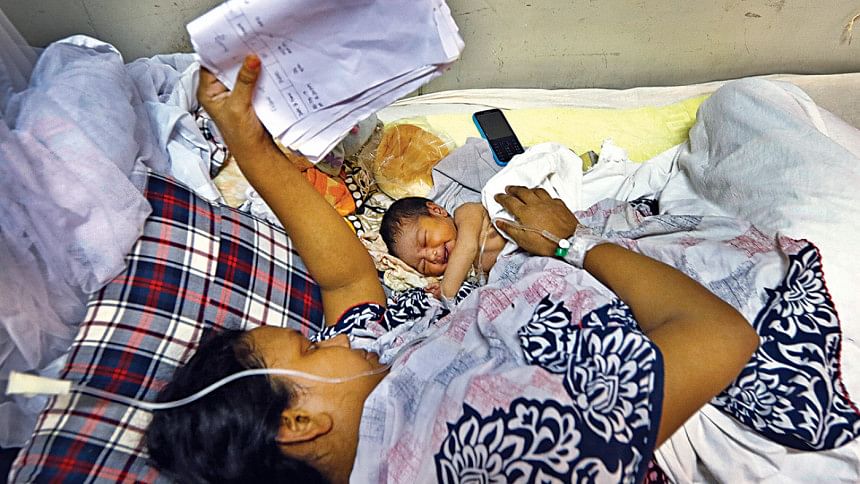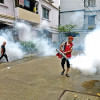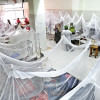Six hours at Suhrawardy

Five hours and 15 minutes.
That is how long it took Mohammad Alauddin, a mason from Mirpur’s Kazipara, to get a bed at the Shaheed Suhrawardy Medical College Hospital in the capital. Even then, it took the intervention of the hospital’s director to get him admitted.
The Daily Star correspondents, during a six-hour visit, followed Alauddin for the entire time, except for when he was being consulted by doctors.
Suffering from fever, headaches and stomach cramps, Alauddin’s ordeal began when he reached the hospital at 9:30am and had to stand in queue for about one hour just to get an outdoor ticket.
Alauddin, 26, had been suffering from high fever for over a week.
He had visited the hospital on Thursday, but tested negative for dengue. As his situation deteriorated, he went to a private hospital on Monday for further tests, which confirmed that his platelet count had dropped to 35,000. Any count below 150,000 instantly alerts doctors of something wrong.
Seeing the results, a tensed Alauddin went to the Suhrawardy hospital.
After an hour’s wait, he finally got the ticket. But there was another queue to see the doctor. Standing in another line in Block 4, Alauddin began to feel worse. A few fans whirred lazily above him, but it did nothing to make the overcrowded corridor feel any less sultry or stuffy.
After 15 minutes of his uncomfortable stay there, Alauddin was informed by a hospital staffer that he was in the wrong queue.
Hapless, the already physically weakened Alauddin rushed to the right line. At about 11:00am, he could not stand any longer and sat on the floor. He finally met medical officer Lina Kazi after another 15 minutes had passed.
The medical officer advised him to get admitted to the hospital.
While the advice was simple on the surface, it revealed yet another layer of complications.
After depositing money for admission, Alauddin visited the emergency ward for other formalities. The on-duty doctor there advised him to take a few more tests to confirm whether he had dengue and then revisit the resident physician’s office.
Around noon, the resident physician office staffers asked Alauddin to get admitted to the hospital the next day after getting the new test reports.
After giving blood samples at about 12:20pm, Alauddin’s headache and stomach cramps intensified. He returned to the emergency ward where on-duty doctors put him in observation for 30 minutes.
Alauddin then visited a top official of the hospital as he felt he needed to be admitted immediately, instead of waiting another day. The hospital official then made arrangements for Alauddin, who got the permission for admission at 1:40pm.
He reached the designated ward where on-duty doctors advised him to take some more tests, including an ultrasound, and the IgG and IgM tests.
After doing all these, he was finally given a mattress on the floor of the ward 1. Hospital authorities put him on saline drip at about 2:50pm.
“We are still loaded with dengue patients. There are over 200 patients, including 73 dengue-infected, taking treatment at ward no 1, which has the capacity to treat 60 patients,” said hospital Director Uttam Kumar Barua.
Regarding Alauddin, he said the admission should have happened sooner. “The admission process has been made easier and we want to make it even easier. Usually, we do not delay the admission of such patients,” he said, adding that since the patient’s platelet had dropped so low, he should have been admitted immediately.
He said once he was informed of Alauddin’s plight, he immediately instructed that the patient be admitted.
“I will look into why such a delay took place,” Barua said.
PATIENT NUMBERS OUTPACE CAPACITY
These correspondents and a photojournalist spent six hours from 9:00am to get a first-hand account of the dengue situation at the state-run Shaheed Suhrawardy Medical College Hospital.
During the visit, many patients were found lying in beds under mosquito nets, while others were taking treatment in the empty spaces between two beds at both special dengue wards for male and female patients.
A critical dengue patient, Sumaiya Akter, rested at a corridor of the hospital. She had just given birth to a baby on August 25. Due to lack of beds at the gynaecology ward, she was placed at the corridor, where she lay with her new-born baby. “We are both suffering the hot and stuffy condition here,” she said at about 1:30pm. She had brought along a small electric fan, but it did little to improve the situation.
A similar sight was found in most of the wards.
Some patients, who did not get a bed, were sleeping in the hospital’s balconies or walkways without mosquito nets. This was seen more in the pediatric ward and ward no 1.
A pungent odour came from a corner, where toilets of the ward for children and ward no 1 had overflowed. The surroundings of the wards were also unclean.
A number of people were coming in and going out. There seemed to be no restriction on visitors.
Several doctors and nurses, while talking to the correspondents, said that they were really tired as they needed to work long hours without weekends for three to four weeks.
“Overworked doctors and nurses are already getting sick,” said a doctor working at the special ward for dengue patients.
“Yes, they are exhausted. They need to attend to so many patients. They need to work two shifts in a row,” assistant director of the hospital, KM Mamun Murshed, said.
He said they were trying to keep the hospital clean.
Although the number of dengue patients decreased over the last few days, there were still many coming to the hospital, Director Barua said. Currently, there were 279 dengue patients taking treatment at the hospital, with a daily average admission of around 45 to 55.
According to hospital authorities, prior to the ongoing spell of dengue fever, they were treating 1,100-1,200 patients per day, but now the number was 1,500-1,600. The hospital has 850 beds with 350 doctors.
Apart from admission, every day, around 500-600 people come to the hospital for dengue tests.
During the first week of August, the hospital was so congested that they had to advise less critical patients to take treatment at home.
To deal with the growing number of patients, hospital authorities have set up two new temporary wards dedicated to those with dengue, with each having a capacity of 120 official beds and 60 portable beds. They also have 10 doctors, 32 nurses and 5 technicians for managing dengue patients.
The country is currently witnessing the worst ever dengue spread. A record 66,064 dengue patients were admitted to different hospitals across the country till yesterday, according to the Directorate General of Health Services (DGHS).
A total of 118 people died of dengue, however, DGHS has confirmed 52 deaths so far.


 For all latest news, follow The Daily Star's Google News channel.
For all latest news, follow The Daily Star's Google News channel. 








Comments